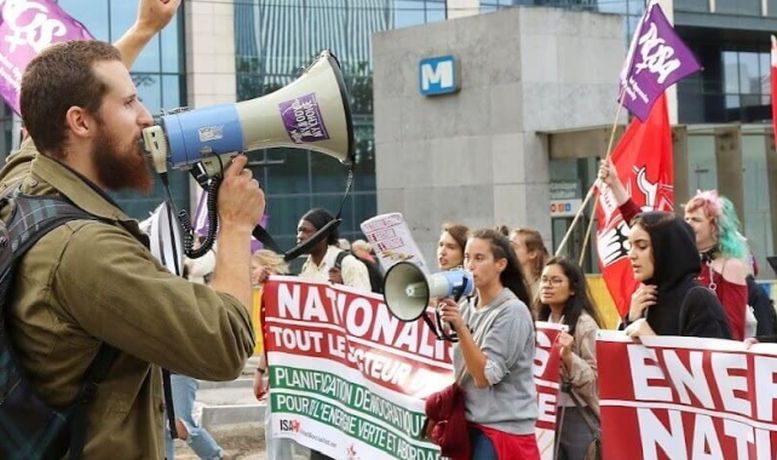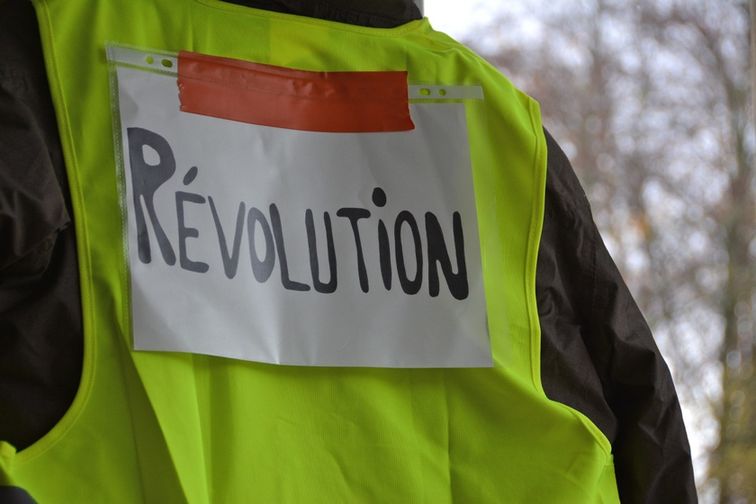Julien Daigneault and Hubert Grenon are members of Alternative Socialiste (ISA in Quebec). Bill Hopwood is a member of Socialist Alternative Canada.
Humans “with flesh, blood, and brain, belong to nature, and exist in its midst.” Engels
Life on earth is in the midst of the “sixth mass extinction.” One in ten plants and animals could be extinct by 2050, rising to one in five by 2100.
This is the context of the UN Conference on Biodiversity meeting in Montreal held from December 7 to 19, entitled COP15. It, like the recent conference on climate change, COP27, has produced some fine words but a woefully inadequate action plan.
The Strategic Plan for Biodiversity 2011-2020 was established in 2010 at COP10. A decade later none of the targets have been fully achieved.
The first international convention on biodiversity was established in Rio de Janeiro, Brazil at the Earth Summit in 1992 — yet the rate of extinction and loss of ecosystem are getting worse.
In the last 50 years, 17percent of the Amazon rainforest has been logged, mainly for raising cattle, but is also impacted by mining. Much of the forest’s rainfall is due to evaporation within the forest. As the forest is logged there is less evaporation and researchers have argued that if 20 to 25 percent of the forest is destroyed the decline in rain will turn it into a grassland savannah.
Coral reefs have one of the highest levels of biodiversity on the planet. They are threatened by oceans warming and becoming more acidic, both due to CO2 in the atmosphere. By 2030 90 percent of the coral reefs will be threatened. Reefs are also under threat from overfishing, pollution and excessive tourism. Reefs provide humans with food and help protect coastlines from storms.
Many ecosystems are threatened by climate change. The Arctic is warming four times faster than the global average. This endangers both individual species of animals and plants, and the entire ecology and the lives of the people who rely on it.
Insects Disappearing
Often when talking about disappearing species, it is big animals that get attention — polar bears, whales, tigers and the like. Ecosystems are much more than their emblems. Regardless of the kingdom (including plant, animal, fungi, bacteria) of the threatened species, their extinction would have dire consequences. The disappearance of species at the bottom of the food chain can spread throughout an ecosystem.
Insects are the most abundant type of animal on earth and they are disappearing at a terrifying rate. They are going extinct eight times faster than mammals, birds and reptiles. In some parts of the world insect abundance has fallen by 50 percent. Insects’ total mass is dropping by 2.5 percent every year. This risks a “catastrophic collapse of nature’s ecosystems.”
Insects are the main pollinators of plants, and they clear up huge quantities of organic waste, aerate the soil and provide food for a vast array of other animals.
Insects are being driven to extinction primarily by agribusinesses farming methods, which causes loss of habitat, widely use toxic pesticides (especially neonicotinoids), produce single crop landscapes devoid of any variety, and climate change.
Much of the food humans eat relies on insects for pollination. Bees are responsible for pollinating about one-third of the world’s food supply including chocolate, coffee, most fruits and nuts and many vegetables. Bees, both wild and domesticated, are in sharp decline. In the US, 30 percent of honeybee colonies are lost every winter.
If the pollinators disappear who or what will take over the pollination of ecosystems and of crops? It is unimaginable that farm workers could do it manually, although this is done in some places due to the lost of insects. Miniature drones would be prohibitively expensive and unlikely to work. The only realistic solution is to protect insects and ecosystems that support them.
30 x 30
The highest profile agreement of COP15 is to conserve both 30 percent of land area and 30 percent of ocean areas by 2030 through “area-based conservation measures,” such as parks. Canada has said it will reach this goal, although currently only 13.5 percent of land and freshwater, and 13.9 percent of marine territory, are protected.
This agreement required strong pressure on several Africa countries to accept. Initially, the Democratic Republic of Congo, home to most of the second largest tropical rainforest in the world, stated it did not agree. Representatives from Cameroon said it was “a fraud,” and Uganda talked of a “coup d’état.” Their objection was because they are expected to protect their forests without any support from the rich countries that, in many cases, have logged much of their previous forests. In the end they were persuaded to agree.
However, preserving life and ecosystems is not a simple as 30 percent of land or ocean. If Canada protects 30 percent of boreal forest it will do nothing for life in other ecosystems. Some of the formerly most diverse ecosystems in Canada have been transformed. The Carolinian Forest ecosystem, in southern Ontario, is now almost all cities and farms. Canada’s only desert outside of the Arctic, in the southern Okanagan, is now mainly farms and houses.
Even if the land area of the boreal forest is protected, the ecosystem is not, as Canada’s north is warming several times faster than the global average. The Canadian government plans to increase the production of fossil fuels, increasing the threat to the north’s ecology.
Indigenous communities have a major criticism of this proposal. There is a false belief that the natural world was wilderness, untouched by humans. All of earth’s landscapes, except Antarctica, were influenced by humans. Humans shaped the ecology of the Amazon rainforest, for example. The idea of “wilderness” resulted in the Indigenous people being expelled from the first US national Park, Yellowstone, although they had lived there for thousands of years.
“Fortress conservation,” safeguarding ecosystems by establishing protected areas, continues the long history of abuse of Indigenous people.
Money
A major division at COP15 is about money. “It’s really about developed countries versus developing countries, … the dynamic below the surface is about power, is about influence, it’s about money and it’s about benefits,” according to Tim Hodges, a Canadian veteran of biodiversity negotiations.
Countries with high biodiversity want compensation from the richer ones for the exploitation of their biodiversity and to protect land areas. The UN estimates that $200 billion a year is needed on top of ending the $500 billion a year in subsidies to environmentally damaging actions. These subsidies go to large corporations that make their profits from fossil fuels, destructive mining, and intensive agriculture. There is money to destroy the environment but not so much to protect it or help humans.
On December 14, delegates from over 60 countries walked out in protest at the lack of progress on finances. The final agreement has vague statements to reduce subsidies and raise money but no firm commitment to raise $200 billion annually, only that developed countries will raise between $20 billion to $30 billion a year by 2030.
Vague Hopes
The COP15 agreement states that countries will “ensure” corporations report on biodiversity. Some mechanisms will be created to ensure countries with high biodiversity get some benefits when private corporations such as pharmaceuticals make large profits out of exploiting natural products. The agreement aims to reduce the “risk” from pesticides. COP15 agreed that countries ought to be “working towards eliminating plastic pollution,” but there are no targets.
The final agreement recognizes Indigenous rights; however, BC and Canada have both enacted laws to implement the United Nations Declaration on the Rights of Indigenous Peoples, yet constantly ignore Indigenous rights.
There is no method to enforce any of the aims, hopes or goals. This in contrast to international trade agreements that give corporations the right to sue countries even for the loss of potential profits. None of the commitments are compulsory: it is all left to hope.
How to Make Change
As the loss of biodiversity and climate change accelerate and not enough is done there is a growing debate on how to win change. There is growing awareness that much of the talk from government and big business is greenwashing. Some activists are looking to direct action, such as blocking roads or throwing paint at famous paintings. These strategies aim to attract high media attention to pressure political and economic elites to change course.
Many mainstream big environmental groups seek to persuade politicians to act. Canada’s environment minister, Steven Guilbeault, embodies this. He was an activist, arrested for high profile actions with Greenpeace. Now he is at the negotiating table. However, the price to sit at the table is to agree that Canada will produce more fossil fuels, which will further drive climate change and the assault on biodiversity.
A more positive and realistic step is the creation of the COP15 Collective, composed of 103 civil society groups, including three major Québec trade union federations with more than one million members combined. This collective has enormous potential to lay the foundations of a democratic structure that would help build a powerful movement linking the climate and workers’ interests. However, the Collective limits itself to wanting to “incite governments to take ambitious and concrete actions” for the “safeguarding of life.”
It is unrealistic to demand that decision makers and global elites will take the necessary steps. More frequently, governments attack Indigenous and young people fighting for the planet and instead, protect big business that pollutes. Oil pipelines regularly leak, the latest being the Keystone pipeline in Kansas, which spilled about 600,000 gallons of diluted bitumen. The Canadian government is paying at least $21.4 billion to build a pipeline that will carry diluted bitumen across 500 rivers and streams in BC on its way to the port of Vancouver. Over 220 people, especially Indigenous and elders, have been arrested trying to stop the Trans Mountain pipeline that could have devastating impacts.
A mass movement is needed to force change. Direct actions can be powerful tools, when they are organized jointly with workers who go on strike. They attack the profits that employers make by exploiting the environment and workers. Such mass climate actions will require organizing by union grassroots activists.
Young people are often leading the struggles to stop climate change and protect biodiversity. Youth, workers and Indigenous people, linked in joint struggle, have the power to make change.
There are growing signs internationally of activists looking to the workers’ movements. In Britain, Just Stop Oil and Extinction Rebellion have supported striking railway workers. Last year in Austria, the group Lobau Bleibt raised money to cover the lost wages of workers at the construction site the group occupied.
Clarity about the Real Culprits
The UN’s International Panel on Biodiversity pointed out in July 2022 that “short-term profits and economic growth” are taking precedence over ecosystem health around the world. The UN Secretary General, Antonio Guterres, stated at the start of COP15 that the large multinationals “fill their bank accounts while emptying our world of its natural wealth.”
Yet at COP 15 there are hundreds of representatives of these very same big corporations lobbying to protect their interests.
The logic of capitalism puts profits before human beings and the planet. The profits come from robbing nature and exploiting workers. If the robbing and exploiting ended, there would be no profits, so it is illogical to expect capitalists and their political spokespersons to reverse the path to environmental disasters.
Winning the unions to a program to protect biodiversity and tackle climate change is a crucial part of the struggle for human well-being. Still too many union leaders accept the false claim that it is a choice between jobs and environment. They also are often unwilling to fight for workers’ wages and conditions, as demonstrated by many Canadian union leaders recommending below inflation pay deals that cut living standards. Workers need unions that fight for both jobs and the environment. Moves such as the COP15 Collective, in Québec, and the Campaign against Climate Change Trade Union Group in Britain that is campaigning for one million good jobs through tackling climate change are important steps forward.
Environmental activists who put forward a program that combines good union jobs with protecting the world’s climate and biodiversity can build strong link with union activists.
Democratic Control
The obstacle to making an ecological transition and guaranteeing biodiversity is not technical or scientific. It is not a matter of “awareness.” It is obvious to millions of people that capitalism causes climate change, pollution and massive biodiversity loss. The obstacle is the control that tiny capitalist elites around the world have over the management of resources and territories.
Over 100 years ago, the Russian Bolsheviks led by Lenin and Trotsky achieved the first workers’ revolution in history. Within two days of taking power, in a country devastated by World War I, the Bolsheviks nationalized water, forests and minerals. During the civil war (1918-1921), the Bolsheviks protected huge territories from logging and hunting. They created nature reserves dedicated to scientific research (zapovedniks), a global first.
Addressing the health problems and potentially irreversible damage to ecosystems requires taking public ownership, with democratic control, of banking, transport, energy, mining and forestry industries. This inevitably means fighting the Canadian petro-state and tax haven for the world’s mining companies.
The struggle is international. The loss of biodiversity and death of species is global. International Socialist Alternative is building the global struggle for humanity’s future.



